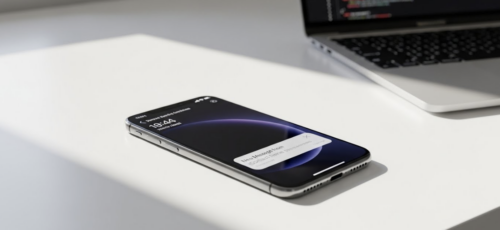Modern businesses need direct customer communication channels that deliver results, and SMS and MMS messaging APIs provide 98% open rates with instant delivery capabilities.
Key advantages include:
- Seamless integration with existing systems
- Support for both text and multimedia content
- Scalable infrastructure that grows with your application
For developers building customer engagement features, messaging APIs offer the fastest path to reliable, enterprise-grade communication without complex telecom infrastructure.
Business communications are much different in 2025, with 84% of consumers now opting in to receive SMS messages from businesses. As a developer, you’re likely tasked with building communication features that meet these rising expectations while maintaining the technical reliability your applications demand.
SMS and MMS messaging APIs are now the backbone of modern business communication, enabling developers to integrate powerful messaging capabilities directly into applications, CRMs, and automated systems. These APIs eliminate the complexity of building telecom infrastructure from scratch, providing platforms that handle carrier relationships, compliance requirements, and message routing.
Whether you’re enhancing a SaaS product with notification features or building customer engagement tools for clients, understanding how to leverage SMS and MMS messaging APIs effectively can transform your development capabilities and deliver measurable business impact.
What Are SMS and MMS Messaging APIs?
An SMS and MMS messaging API serves as a programming interface that enables applications to send and receive text and multimedia messages through simple HTTP requests. These APIs act as a bridge between your application and telecommunications carrier networks, handling the complex routing and delivery processes that ensure messages reach their intended recipients.
SMS (Short Message Service) APIs focus on text-only communication with a 160-character limit per segment. When messages exceed this limit, the API automatically segments them into multiple parts that appear as a single message to recipients. SMS is ideal for notifications, alerts, confirmations, and other concise communications that require immediate attention.
MMS (Multimedia Messaging Service) APIs support images, videos, audio files, and longer text content up to 1,600 characters. This capability opens possibilities for richer customer engagement, visual product demonstrations, and interactive communication experiences that weren’t possible with traditional SMS alone.
Modern messaging APIs in 2025 operate primarily through RESTful architecture, making them compatible with virtually any programming language and development environment. They use standard HTTP methods like POST and GET, with JSON-formatted requests and responses that integrate seamlessly into existing application workflows.
The key technical advantage lies in abstraction. Rather than managing carrier relationships, protocol translations, and delivery confirmations manually, developers can focus on building features while the API handles infrastructure complexity. This approach reduces development time from weeks to hours and eliminates the ongoing maintenance burden of managing telecom connections.
Why Are SMS and MMS APIs Critical for Modern Developers?
The demand for real-time communication features has never been higher. Recent research finds that 90% of people prefer to communicate by text, even when dealing with businesses. Failing to meet these communication preferences can directly impact user satisfaction and business outcomes.
From a technical perspective, SMS and MMS messaging APIs solve several critical development challenges. They provide instant scalability without requiring infrastructure investment, offer built-in compliance features for regulations like TCPA and GDPR, and deliver enterprise-grade reliability with uptime guarantees exceeding 99.9%.
Security is another advantage. Professional messaging APIs include features like message encryption, secure authentication protocols, and fraud protection measures that would be expensive and time-consuming to implement independently. They also handle carrier-specific requirements and routing optimizations that ensure messages reach recipients regardless of their mobile network provider.
For development teams, SMS API integration reduces complexity while expanding capabilities. You can implement sophisticated communication workflows using familiar programming patterns, integrate with existing databases and user management systems, and scale messaging volumes dynamically based on application usage patterns.
The business impact is equally compelling. Applications with integrated messaging capabilities see higher user engagement rates, improved customer satisfaction scores, and better conversion rates for time-sensitive actions like appointment confirmations or purchase completions.
SMS vs MMS API: Technical Capabilities and Implementation
Understanding the technical differences between SMS and MMS APIs helps you choose the right approach for specific use cases and optimize implementation strategies accordingly.
SMS APIs excel in scenarios requiring immediate delivery and universal compatibility. Every mobile device supports SMS, making it the most reliable option for critical notifications like security codes, appointment reminders, or system alerts. The 160-character limit forces concise messaging, which often improves user comprehension and response rates.
Implementation typically involves simple HTTP POST requests with parameters for recipient phone number, message content, and optional features like delivery confirmation callbacks. Most SMS APIs support bulk messaging capabilities, allowing you to send thousands of messages with a single API call while maintaining individual personalization.
MMS API messaging provides enhanced engagement opportunities through multimedia content support. You can send product images, instructional videos, promotional graphics, or document attachments directly within the message thread. This capability is valuable for e-commerce applications, customer support systems, and marketing campaigns that benefit from visual communication, making an MMS API for communication a powerful tool for developers.
The technical implementation for MMS requires additional considerations around file size limits (typically 750KB), supported file formats, and recipient device capabilities. Modern MMS API for communication platforms handle format conversion and resizing automatically, but understanding these constraints helps optimize content for maximum compatibility.
Key Integration Differences
SMS Integration Considerations:
- Simpler payload structure with text-only content
- Faster processing and delivery times
- Lower per-message costs
- Universal device compatibility
- Automatic message segmentation for longer content
MMS Integration Requirements:
- File upload handling and encoding
- Content type validation and optimization
- Larger bandwidth requirements
- Variable device support across carriers
- Higher message costs but improved engagement potential
Both APIs share common integration patterns, including webhook support for delivery notifications, rate limiting configurations, and error handling protocols that ensure reliable message delivery even during high-volume periods.
How Are 2025 Trends Transforming SMS and MMS API Development?
Messaging APIs are evolving thanks to artificial intelligence, enhanced personalization requirements, and emerging communication protocols that expand traditional SMS and MMS capabilities.
AI-Powered Message Optimization
Generative AI tools are redefining how businesses create and optimize messaging campaigns, offering developers new integration opportunities. Modern messaging APIs now include AI-assisted features like send-time optimization, content generation suggestions, and automated A/B testing capabilities.
APIs that can analyze recipient engagement patterns and automatically schedule messages for optimal delivery times. Advanced platforms provide machine learning models that suggest message content improvements based on historical performance data and recipient preferences.
Enhanced Personalization and Segmentation
Modern messaging APIs support sophisticated segmentation capabilities beyond demographic targeting. Developers can integrate behavioral data, purchase history, and real-time user interactions to create highly personalized message experiences.
APIs now offer dynamic content insertion, allowing you to customize messages with recipient-specific information like names, account balances, or recommended products without requiring separate API calls for each recipient.
RCS Integration and Rich Communication Features
Rich Communication Services (RCS) is the next evolution of messaging, supporting interactive elements like buttons, carousels, and forms within message threads. While still gaining adoption, forward-thinking developers are beginning to integrate RCS capabilities alongside traditional SMS and MMS APIs.
Conversational AI and Two-Way Messaging
The shift toward conversational experiences has made two-way messaging capabilities essential. Modern APIs provide sophisticated webhook systems that enable real-time message processing, automated response generation, and seamless handoffs between automated and human support agents.
What Business Applications Are Driving SMS and MMS API Adoption?
The practical applications for SMS messaging for business span virtually every industry, with specific use cases demonstrating measurable impact on operations and customer satisfaction.
Customer Service and Support Automation
Customer service is one of the top drivers of SMS messaging for business, making it a leading use case for messaging API adoption. In one recent customer service research study, 63% of customer service teams use text messaging as a support channel, underscoring how text-based interactions are becoming central to modern service. Developers are building systems that automatically route customer inquiries based on keywords, provide instant responses to common questions, and escalate complex issues to human agents seamlessly.
Implementation typically involves integrating messaging APIs with existing CRM systems, knowledge bases, and ticketing platforms. Integration creates unified communication experiences where customers can initiate support requests via text and receive updates throughout the resolution process.
Security and Authentication Systems
Two-factor authentication and passwordless login systems rely heavily on SMS APIs for delivering security codes and verification links. The immediate delivery and high open rates make SMS ideal for time-sensitive security communications.
Modern implementations include features like code expiration, retry logic for failed deliveries, and integration with identity management platforms. Developers can build comprehensive authentication workflows that enhance security without compromising user experience.
Appointment and Event Management
Healthcare, professional services, and other appointment-based businesses use messaging APIs to reduce no-shows and improve scheduling efficiency. Automated appointment reminders can reduce no-show rates by up to 38%, delivering operational improvements.
Advanced implementations include two-way confirmation capabilities, rescheduling options, and integration with calendar systems. Patients or clients can respond to reminder messages with simple commands to confirm, cancel, or reschedule appointments automatically.
E-commerce and Transaction Notifications
Online retailers leverage messaging APIs for order confirmations, shipping notifications, delivery updates, and cart abandonment recovery. The immediate nature of SMS helps maintain customer engagement throughout the purchase and fulfillment process.
Sophisticated implementations include personalized product recommendations, dynamic delivery tracking updates, and automated follow-up sequences that encourage repeat purchases based on customer behavior patterns.
Marketing Campaign Automation
SMS marketing continues to deliver one of the strongest returns of any communication channel, thanks to high open rates, immediate delivery, and measurable engagement. Developers are building campaign management systems that segment audiences, personalize content, and optimize sending schedules automatically.
Modern marketing implementations include features like:
- Behavioral trigger campaigns based on user actions
- Dynamic content personalization using customer data
- Automated compliance management for opt-ins and opt-outs
- Integration with email and social media platforms for omnichannel campaigns
- Real-time performance analytics and optimization recommendations
What Should Developers Consider When Implementing SMS and MMS APIs?
Successful messaging API implementation requires attention to technical architecture, compliance requirements, and scalability that ensure reliable performance as usage grows.
API Architecture and Integration Patterns
RESTful API architecture provides the most compatible and scalable foundation for messaging integrations. Look for APIs that support standard HTTP methods, JSON request/response formats, and clear error handling protocols.
Key architectural considerations include:
- Asynchronous processing capabilities for high-volume messaging
- Webhook support for delivery confirmations and status updates
- Rate limiting configurations that match your application requirements
- Retry logic and error handling for failed message deliveries
- Queue management systems for processing large message batches
Security and Compliance Implementation
Messaging APIs must comply with regulations like TCPA (Telephone Consumer Protection Act), GDPR (General Data Protection Regulation), and industry-specific requirements for healthcare or financial services. Choose platforms that provide built-in compliance features rather than implementing these requirements manually.
Essential security features include:
- API key authentication with role-based access controls
- Message encryption in transit and at rest
- Audit logging for compliance reporting
- Opt-in/opt-out management with automatic list maintenance
- Fraud detection and prevention capabilities
Scalability and Performance Optimization
Modern messaging APIs should handle everything from a few messages per day to millions of messages during peak periods without requiring architectural changes. Design your integration with scalability in mind from the beginning.
Performance optimization strategies include:
- Connection pooling and persistent HTTP connections
- Batch processing for bulk message operations
- Caching mechanisms for frequently accessed data
- Load balancing across multiple API endpoints
- Monitoring and alerting systems for performance tracking
Message Content and Delivery Optimization
Consider content strategies that maximize engagement while respecting user preferences and communication best practices.
Content optimization approaches include:
- Message length optimization for different audience segments
- A/B testing frameworks for content and timing experiments
- Personalization engines that customize messages based on user data
- Multi-language support for international applications
- Rich media optimization for MMS content
How Do You Choose the Right Messaging API Solution?
Selecting the appropriate messaging API provider requires evaluating technical capabilities, business requirements, and long-term scalability that align with your development objectives and client expectations.
Technical Evaluation Criteria
Start by assessing the API’s technical specifications and integration requirements. The platform should support your preferred programming languages, provide comprehensive documentation, and offer development tools that accelerate implementation.
Critical technical factors include:
- API response times and reliability guarantees
- Geographic coverage and carrier relationships
- Message throughput capabilities and rate limits
- Development tools like SDKs, code samples, and testing environments
- Integration support for popular platforms and frameworks
Feature Comparison Framework
Different providers offer varying feature sets that can impact your application’s capabilities. Create a comparison matrix that evaluates features against your specific use case requirements.
Essential features to evaluate:
- SMS and MMS support with multimedia file handling
- Two-way messaging capabilities and webhook integrations
- Number provisioning and management tools
- Analytics and reporting capabilities
- Compliance and security certifications
- Customer support quality and availability
Cost Structure Analysis
Messaging API pricing varies between providers, with different models that can impact your total cost of ownership. Consider both direct messaging costs and indirect expenses like development time, maintenance requirements, and feature limitations.
Common pricing models include:
- Per-message pricing with volume discounts
- Monthly subscription plans with included message allowances
- Pay-as-you-go models with no minimum commitments
- Enterprise pricing with custom rate negotiations
Vendor Stability and Support
Choose providers with proven track records, strong financial backing, and comprehensive support offerings. The messaging infrastructure you select will become critical to your application’s reliability, making vendor stability a key selection criterion.
Evaluation factors include:
- Company history and financial stability
- Customer references and case studies
- Support availability and response times
- Documentation quality and developer resources
- Roadmap transparency and feature development pace
How Can You Get Started with SMS and MMS API Implementation?
Beginning your messaging API integration requires a systematic approach that addresses planning, development, testing, and deployment phases while ensuring compliance and optimal performance from launch.
Pre-Implementation Planning
Before writing code, define your messaging requirements, target audience characteristics, and success metrics that will guide development decisions. This planning phase prevents scope creep and ensures your implementation effectively meets business objectives.
Key planning considerations:
- Message volume projections and scaling requirements
- Audience segmentation and personalization needs
- Integration points with existing systems and databases
- Compliance requirements for your industry and target markets
- Performance benchmarks and success metrics
Development Environment Setup
Most modern messaging APIs provide developer-friendly tools, including sandbox environments, testing phone numbers, and comprehensive documentation that accelerate initial development and testing cycles.
Setup steps typically include:
- Account creation and API key generation
- SDK installation for your preferred programming language
- Sandbox environment configuration for testing
- Webhook endpoint setup for delivery notifications
- Initial authentication and connection testing
Implementation Best Practices
Follow established patterns for messaging API integration that ensure reliability, maintainability, and scalability as your application grows. These practices help avoid common pitfalls that can impact message delivery or user experience.
Recommended implementation approaches:
- Implement comprehensive error handling and retry logic
- Use asynchronous processing for high-volume operations
- Cache frequently accessed data to minimize API calls
- Implement proper logging and monitoring systems
- Design for graceful degradation during API outages
Testing and Quality Assurance
Thorough testing ensures your messaging implementation works reliably across different scenarios, device types, and usage patterns. Develop test plans that cover both technical functionality and user experience aspects.
Testing strategies include:
- Unit testing for individual messaging functions
- Integration testing with third-party systems
- Load testing for high-volume scenarios
- Cross-carrier testing for message delivery
- User acceptance testing with real devices and networks
Production Deployment and Monitoring
Deploy your messaging features with comprehensive monitoring and alerting systems that provide visibility into performance, delivery rates, and user engagement metrics. This data helps optimize your implementation and identify issues before they impact users.
Monitoring considerations include:
- Message delivery rates and failure analysis
- API response times and error rates
- User engagement metrics and feedback
- Cost tracking and budget management
- Security monitoring and compliance reporting
Frequently Asked Questions
What’s the difference between SMS and MMS APIs in terms of implementation complexity? SMS APIs are generally simpler to implement, requiring only text content and recipient information. MMS API messaging requires additional considerations around file size limits (typically 750KB), supported file formats, and recipient device capabilities.
How do messaging APIs handle international message delivery? Professional messaging APIs maintain carrier relationships globally and handle routing, compliance, and formatting requirements automatically. They typically provide country-specific pricing and delivery optimization without requiring changes to your application code.
What security measures should I implement when using messaging APIs? Essential security practices include API key protection, message content validation, rate limiting, and webhook signature verification. Choose providers that offer encryption, audit logging, and compliance certifications for your industry requirements.
How can I optimize message delivery rates and engagement? Focus on permission-based messaging, content personalization, optimal timing based on recipient preferences, and clear opt-out mechanisms. Monitor delivery analytics and adjust strategies based on performance data and user feedback.
What compliance requirements apply to SMS and MMS messaging? Key regulations include TCPA for consent requirements, GDPR for data protection, and industry-specific rules for healthcare, finance, and other sectors. Choose API providers that offer built-in compliance features and stay updated on regulatory changes.
Integrate Powerful Messaging Into Your Apps
SMS and MMS messaging APIs have become essential tools for developers building modern customer engagement features. The combination of high open rates, immediate delivery, and universal device compatibility makes messaging a powerful addition to any application’s communication capabilities.
Success with messaging APIs depends on choosing the right provider, implementing best practices for scalability and compliance, and focusing on user experience throughout the integration process. The technical complexity of managing carrier relationships, routing optimization, and regulatory compliance makes partnering with an experienced provider crucial for long-term success. Get started with Flowroute’s developer-friendly SMS and MMS APIs and build communication features that deliver results for your clients and users.

Mitch leads the Sales team at BCM One, overseeing revenue growth through cloud voice services across brands like SIPTRUNK, SIP.US, and Flowroute. With a focus on partner enablement and customer success, he helps businesses identify the right communication solutions within BCM One’s extensive portfolio. Mitch brings years of experience in channel sales and cloud-based telecom to every conversation.






